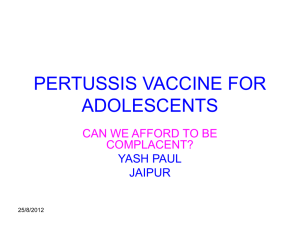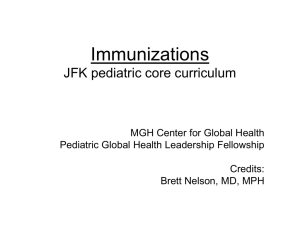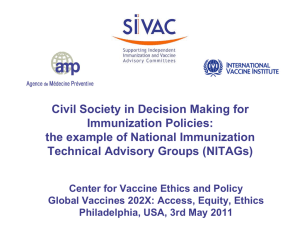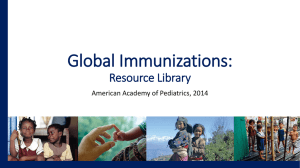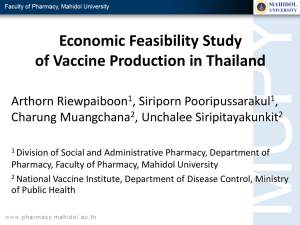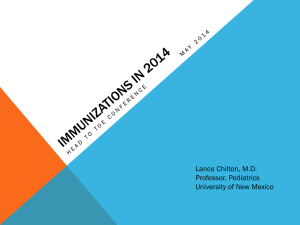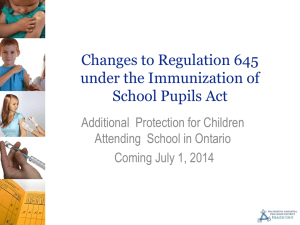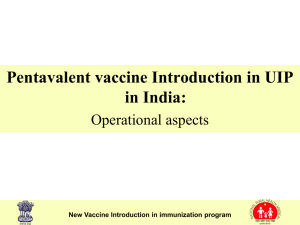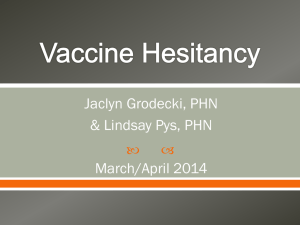VMV-IAP Immunization Timetable 2012
advertisement
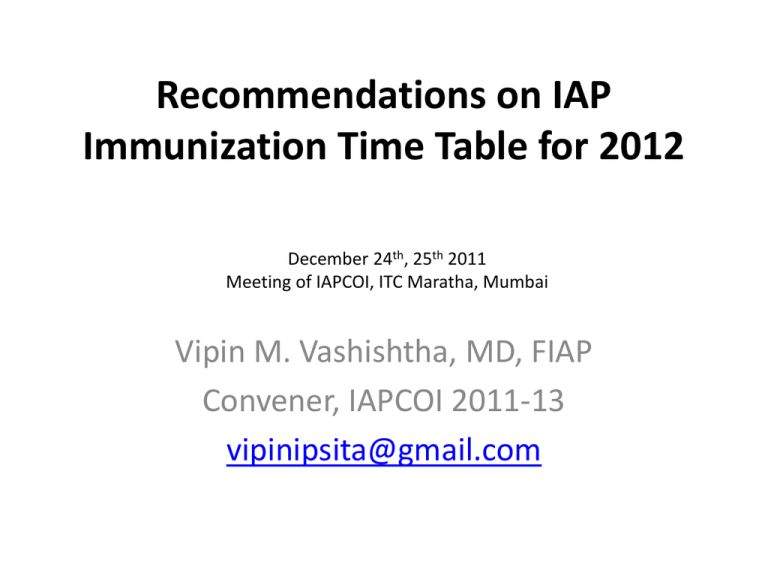
Recommendations on IAP Immunization Time Table for 2012 December 24th, 25th 2011 Meeting of IAPCOI, ITC Maratha, Mumbai Vipin M. Vashishtha, MD, FIAP Convener, IAPCOI 2011-13 vipinipsita@gmail.com • Immunization schedules ought to be dynamic & adaptable to ongoing epidemiological changes & rapid developments in vaccine sciences Existing IAP Immunization Schedules IAP recommended vaccines (2011) I. IAP Immunization Time Table 2011 Footnotes: • OPV alone if IPV cannot be given • *# Rotavirus vaccine (2/3 doses depending on the brand at 4-8 weeks interval) • ** The third dose of Hepatitis B can be given at 6 months • $ The second dose of MMR vaccine can be given at any time 4-8 weeks after the first dose • $ $ Varicella (2nd dose may be given any time 3 months after the 1st dose) • # Typhoid revaccination every 3 years • & Tdap preferred to Td, followed by repeat Td every 10 years • ^ Only females, three doses at 0, 1-2 (depending on brands) and 6 months II. IAP Immunization Schedule for adolescents • IAP recommended vaccines for Adolescents (10 Years to 18 Years) • IAP Recommendations for Catch up Immunization in Adolescents • IAP Recommendations for Adolescent Immunization in Special Circumstances • IAP Recommandations for Adolescents traveller IAP recommended vaccines for Adolescents (10 Years to 18 Years) IAP Recommendations for Catch up Immunization in Adolescents IAP Recommendations for Adolescent Immunization in Special Circumstances IAP Recommandations for Adolescents traveller What changes are needed? • Need to have separate schedules • Need to consolidate footnotes • Need to revise recommendations pertaining to individual vaccines The CDC style timetables: • • • • Three schedules 0 through 6 years 7 through 18 years “Catch-up” – 4 months through 6 years – 7 through 18 years • Each schedule should have separate footnotes I. Recommended Immunization Schedule for Persons Aged 0 Through 6 Years—United States 2011 II. Recommended Immunization Schedule for Persons Aged 7 Through 18 Years—United States 2011 Changes to Individual vaccine recommendations: Hepatitis B vaccine (HepB) CDC new guidelines for Hep-B schedule: • For infants born to HBsAg-positive mothers: • Administer HepB vaccine + 0.5 mL of hepatitis B immune globulin (HBIG) within 12 hours of birth. • These infants should be tested for HBsAg and antibody to HBsAg 1 to 2 months after receiving the last dose of the series. http://www.cdc.gov/vaccines/recs/acip/downloads/mtg-slides-oct11/ChildAdolescent-Immunization.pdf Hep-B • If mother’s HBsAg status is unknown: • Infants weighing ≥ 2000 grams: within 12 hours of birth administer HepB vaccine • Infants weighing < 2000 grams: within 12 hours of birth administer Hep B vacccine + HBIG • Determine mother’s HBsAg status as soon as possible and, if HBsAg-positive, administer HBIG for infants weighing ≥ 2000 grams (no later than age 1 week). http://www.cdc.gov/vaccines/recs/acip/downloads/mtg-slides-oct11/ChildAdolescent-Immunization.pdf Hep-B • Infants who did not receive a birth dose should receive 3 doses of a HepB-containing vaccine starting as soon as feasible http://www.cdc.gov/vaccines/recs/acip/downloads/mtg-slides-oct11/ChildAdolescent-Immunization.pdf Hep-B • • • • The minimum interval between doses: 1 and dose 2: 4 weeks Between dose 2 and 3: 8 weeks The final (3rd or 4th) dose in the HepB series should be administered no earlier than age 24 weeks, and at least 16 weeks after the 1st dose. http://www.cdc.gov/vaccines/recs/acip/downloads/mtg-slides-oct11/ChildAdolescent-Immunization.pdf Suggested modification: • IAPCOI schedule: • Three doses at: • Birth, 6 weeks, & 6 months Tdap vaccine: • CDC recommended use during pregnancy Hib vaccines: • Hib vaccine should be considered for unvaccinated persons aged 5 years or older who have sickle cell disease, leukemia, or HIV infection, or who have had a splenectomy. PCV: Discussion & Vote:
